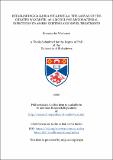Files in this item
Establishing Galleria mellonella, the larvae of the greater wax moth, as a model for mycobacterial infections to assess existing and novel treatment
Item metadata
| dc.contributor.advisor | Coote, Peter John | |
| dc.contributor.author | der Weduwen, Frances | |
| dc.coverage.spatial | 342 p. | en_US |
| dc.date.accessioned | 2020-04-16T13:49:21Z | |
| dc.date.available | 2020-04-16T13:49:21Z | |
| dc.date.issued | 2020-12-01 | |
| dc.identifier.uri | https://hdl.handle.net/10023/19814 | |
| dc.description.abstract | Galleria mellonella, the larvae of the greater wax moth, are cheap, practical and readily-available organisms which can be utilised for a comprehensive range of experimental protocols. They are valuable in vivo intermediaries between in vitro studies and models which require greater investments of time, equipment, and ethical approval. Larvae exhibit cellular and humoral immune responses with structural and functional similarities to mammals. They are ideal for high-throughput screens of pathogens, antimicrobials, toxicity tests, and novel treatments. In this thesis, G. mellonella was used with a range of Mycobacterium species and strains. Mycobacteria represent a unique challenge as they are intrinsically resistant to antibiotics, “hide” from immune responses, and interact directly with immune cells. Mycobacterium tuberculosis, the causative agent in tuberculosis, has infected billions of humans and is notoriously difficult to study due to its slow generation time and ability to infect immunocompetent humans. Hence, using related Mycobacterial species allows assessment of this genus with minimal risk and inconvenience. Using these bacteria in tandem with a simple, easily used in vivo model allows for a greater range of experiments in a standard laboratory. When this thesis commenced, Mycobacteria had not been used with a Galleria model in the modern era, Therefore, M. fortuitum, M. marinum and M. aurum were assessed with G. mellonella and confirmed to cause larval death. Various anti-Mycobacterials were assessed, alongside uncommon treatment combinations such as β lactams and efflux pump inhibitors. The immune response to infection and treatment was evaluated – the number of immune cells, their ability to phagocytose Mycobacteria, and the formation of melanised nodules were all affected by infection and the antibiotics used to treat them. This work demonstrates the suitability of G. mellonella as a model for Mycobacterial infections and indicates how they may be used in further research efforts. | en_US |
| dc.language.iso | en | en_US |
| dc.publisher | University of St Andrews | |
| dc.subject | Mycobacteria | en_US |
| dc.subject | Galleria mellonella | en_US |
| dc.subject | Drug screening | en_US |
| dc.subject | In vivo model | en_US |
| dc.subject | Non-tuberculous mycobacteria | en_US |
| dc.subject.lcc | RC116.M8D4 | |
| dc.subject.lcsh | Mycobacteria | en |
| dc.subject.lcsh | Greater wax moth--Case studies | en |
| dc.subject.lcsh | Drugs--Testing | en |
| dc.title | Establishing Galleria mellonella, the larvae of the greater wax moth, as a model for mycobacterial infections to assess existing and novel treatment | en_US |
| dc.type | Thesis | en_US |
| dc.contributor.sponsor | University of St Andrews. School of Biology | en_US |
| dc.type.qualificationlevel | Doctoral | en_US |
| dc.type.qualificationname | PhD Doctor of Philosophy | en_US |
| dc.publisher.institution | The University of St Andrews | en_US |
| dc.identifier.doi | https://doi.org/10.17630/10023-19814 |
This item appears in the following Collection(s)
Items in the St Andrews Research Repository are protected by copyright, with all rights reserved, unless otherwise indicated.

